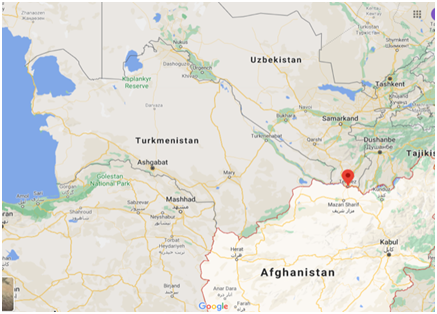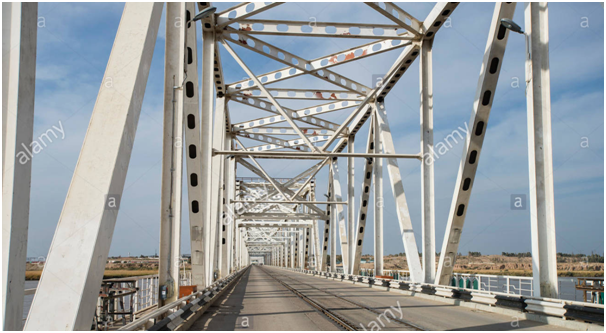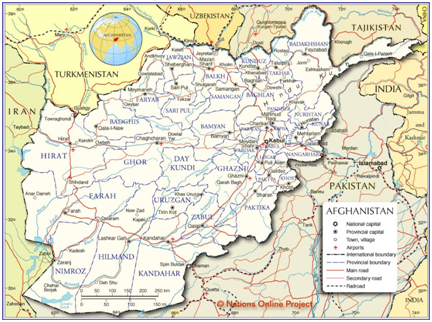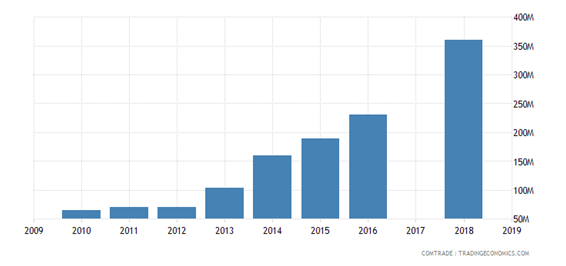
Indian Council of World Affairs
Sapru House, New DelhiFurthering India-Afghanistan-Uzbekistan Economic Ties, 10 November 2020
Within the matrix of India-Central Asia economic relations, probably the most critical subset that needs to be built upon is: India-Afghanistan-Uzbekistan ties, both within bilateral and trilateral frameworks. This is self-evident to an extent, as a large part of the shortest sea-land route from India to Central Asia (excluding the transit route through Pakistan) traverses through these two countries after passing via the port of Chabahar. The other major reason being the potential for joint collaboration these two countries offer.
Looking at the transportation/logistics issue first: The route passes through: Chabahar (Iran) – Zaranj (a border town in Afghanistan and capital of Nimruz province) – Delaram (a transportation centre in Nimruz province, on the Kandahar-Herat Highway) – Herat – Mazar-e-Sharif - dry port of Hairaton (in Balkh province, around 76 km from Mazar-e-Sharif, the capital of Balkh province), before entering the Central Asian region through the dry port of Termez in Uzbekistan, just across the Amu Darya from Hairaton. This route avoids the U.S. sanctions on Iran and the continuing procedural delays at the Iran-Turkmen border.

(Source: Google Maps; screenshot – showing Mazar-e-Sharif and Termez)
A step towards operationalising this route could be taken by discussing the transportation/transit details with forwarding & logistics companies based in Uzbekistan and Iran. These discussions could be held at both, the institutional as well as B2B levels. A preliminary exploration held with some companies in these two countries indicates that these companies are willing to operate, but are concerned about security-related matters and the uncertainty associated with a less used route, especially given the prevailing ground situation in Afghanistan.
Interestingly, their concern is not only due to the fact that Taliban-dominated areas fall along the route, but also on account of being charged multiple times along the way by local warlords and at government check posts. They are of the view that the Taliban after taking money usually guarantee the delivery of goods and do not charge at multiple posts. This is a basic concern that would require resolution by adopting a problem-solving approach. Talking to the Afghan government through Indian Mission in Kabul to streamline toll collection/movement of cargo along the route might help. The transportation companies are ready to “pay once” for secure and safe delivery of goods. They are, however, wary of the uncertainty and the costs associated with multiple payments (at tolls and otherwise) while passing through Afghanistan.
These discussions with freighters/agents will have to be taken forward at both B2B and governmental levels so that a stable environment for transportation and forwarding companies can be built along the Termez - Hairaton - Zaranj route. Incentives such as a small discount on transportation costs for a few years could be considered, or a leading insurance company could be encouraged to come forward to cover the consignments moved along the route at reasonable charges.
Another measure that could be considered is: partnering/investing in the proposed expansion of Termez border post at the Uzbekistan-Afghanistan border. Uzbekistan is planning to develop an International Cargo Terminal for Central Asia at Termez because of its location and road-rail connectivity. It has the potential to become an important cargo transportation and logistics centre (Uzbekistan is a member of the Transport Corridor for Europe Caucasus and Asia - TRACECA).

(Friendship bridge across Amu Darya connecting Hairaton and Termez; source: alamy photo)
Under a trilateral agreement between India, Afghanistan and Uzbekistan, India’s participation in a Special Economic Zone at the Hairaton-Termez Border could be considered, which would be oriented towards the supply of agricultural and Fast-Moving Consumer (FMC) Goods and other related products as per requirements of the three countries. A similar trade zone could be created later at Zaranj (Afghanistan-Iran Border).
Positively assessing the potential for trade with Central Asia, Pakistan has, of late, intensified its efforts towards forging closer trading ties with the region, particularly Uzbekistan. In a recent meeting (Islamabad, Sept 10, 2020), Uzbekistan’s Deputy Prime Minister and Minister for Investment and Foreign Trade Sardor Umurzakov and Pakistan Minister of Maritime Affairs Ali Haider Zaidi discussed establishing a trade corridor and providing Central Asian countries access to Pakistani seaports, including special terminals for Central Asian goods and a dedicated shipping fleet to handle exports from these countries. The two sides also discussed starting negotiations for a Preferential Trade Agreement and agreed to form a Business Forum for the private sector of both countries.
The understanding reached is for movement of inward and outward cargoes through three Pakistani ports that would function as transit ports for Uzbekistan: Karachi, Port Bin Qasim and Gwadar. Similar agreements are said to be in the offing with the other Central Asian countries. Consolidation of these routes would make it difficult for the Termez - Hairaton - Zaranj - Chabahar route to be viable. Already, Uzbek companies have started enquiring from their Indian counterparts whether their goods could be routed through one of the Pak ports. So, the need to quickly move forward with the outreach initiatives, including putting in place preferential trading arrangements, and operationalising the Termez-Chabahar route. The cargo handling capability at Chabahar may also need to be augmented once the port becomes active.
Afghanistan
(Source: Nations Online Project)
Bearing both South Asian and Central Asian identities, Afghanistan is evidently the Gateway for India (and other South Asian countries – Pakistan, Sri Lanka, Bangladesh) to trade with the Central Asian countries. India has worked successfully in Afghanistan in the last two decades building critical infrastructure through a number of big and small projects from the Salma dam (Afghanistan-India Friendship Dam) project to the Zaranj-Delaram road to numerous electric substations, schools and hospitals. The need now is to move up the economic collaboration ladder, and make it market-oriented. This could for instance, increasingly translate into support for the setting-up of suitable small-scale enterprises in Afghanistan.
Notably, the issue of economic growth and achieving a minimum level of self-sufficiency could be an important and positive element of the ongoing intra-Afghan talks. It is an area, which is most likely to see a synergy between the Afghan government side and the Taliban. Focused discussions during the talks on how to put Afghanistan on a positive growth path through the development of local entrepreneurship could be useful. It would enable India to continue to play an important role in supporting economic development in Afghanistan in a bipartisan manner and push the narrative in a positive direction. Even as fighting between the Taliban and the Afghan forces continues, a formal understanding to safeguard installations, infrastructure and economic units could be reached between the two sides.
Afghanistan’s dependency on neighbouring countries for FMC Goods and food items like vegetables is well known. Establishment of manufacturing units producing FMC goods and construction of greenhouses for vegetable cultivation could help Afghanistan exploit its economic potential more fully and also be more self-reliant economically.
India and USAID have been helping Afghanistan in exporting agricultural produce to India and other countries, thereby helping develop its horticulture/plantation sector. Large quantities of dry fruits and medicinal herbs are coming to India from Afghanistan. As a value addition to this trend of growing Afghan exports, it may be a good idea to set-up packaging units in cities like Kabul, Kandahar, Herat and Mazar. Packaging material plants are small-scale projects that can be established quickly. Besides the above cities, setting-up of trade and transportation centres such as at Delaram in Afghanistan could also be explored. Different grades of polyethylene printed packs from 200 gm weight to 1 kg, corrugated cardboard boxes and wooden crates are usually used for packaging of dry fruits and fruits.
Another Small-Scale Industries (SSI) sector India could help establish is that of recycling. Currently, most of the recycling raw material is sent to Pakistan via Peshawar illegally at very low prices. For example, used vehicle batteries and other batteries can be used for extracting lead metal and the plastic used in battery can be used as plastic raw material, as per grade. This plastic can be reused after making flakes, which can, in turn, be used to make plastic switches, utensils, etc. The processed lead metal from these plants can be bought-back by India, or it can be sold globally. Other potential areas of recycling of community waste include: paper/newspapers to make tissue paper, toilet rolls, paper carry bags and packaging material; aluminium utensils/cold drink cans to extract aluminium metal (melting point 660 degree centigrade); metal scrap for making metal ingots and subsequently rolling plants could be set up for making iron rods, which can be used as construction material; old clothes for making rugs, etc.
India can also help develop poultry and animal husbandry sectors in Afghanistan. Currently, the country imports eggs to meet most of its domestic demand. Similarly, sheep and goat breeding are other areas with known potential. Breeding of Merino sheep from which good quality wool can be extracted can be explored. There exists a large demand in India and in the international market for Merino wool. Development of animal husbandry in Afghanistan, in turn, will encourage export of animal feed such as Soya DOC from India and in return India can buy Merino wool. Also, sheep hides can be exported to the Indian leather products industry or these can be exported after a basic value addition, as ‘Wet Blue Leather’.
Another area of collaboration that could be looked at is that of edible grade poppy seeds. Economic entities in Afghanistan can be given licences by the Afghan government for production of edible grade poppy seeds, which is in demand in India, being used in bakery, the pharmaceutical sector and as a spice. Currently, India is importing the same from Turkey, Spain and Italy after getting import licence or clearance from the Narcotics Control Board. Poppy seed imports from Afghanistan could replace imports from Turkey.
It is time to support Afghanistan in diversifying its industrial base, after the growth in its export of agricultural products, by providing technical support in developing Small Scale Industries in the country and creating a buy-back market. Later, India could also consider extending support in setting-up mining, mining-related large-scale industries as Afghanistan is known to be rich in minerals.
India’s trade with Afghanistan has shown a promising trend for both countries and provides a positive backdrop for upscaling bilateral economic ties. Afghanistan’s exports to India were worth USD 359.47 million in 2018, according to the UN COMTRADE database on international trade (figure below). Two categories of products have an overwhelmingly predominant share (more than 88%) in Afghanistan’s export mix to India. These are: (i) Edible fruits, nuts, peel of citrus fruits, melons; and (ii) Lac, gums, resins.

Afghanistan’s imports from India was USD 354.28 million in 2018, according to the UN COMTRADE database on international trade. The trade between the two countries is, therefore, nicely balanced. Afghan imports from India show a more widespread base, and include: (i) Electrical, electronic equipment; (ii) Miscellaneous articles of base metal; (iii) Oil seed, grain, seed, fruits; (iv) Tobacco; (v) textile fibres and different types of fabric; and (vi) Pharmaceutical products.
Uzbekistan
Unlike the trend of India-Afghanistan trade, India’s trade with Uzbekistan has been declining. Indian exports to Uzbekistan were worth USD 261.3 million in 2018 having fallen from USD 318.1 million in 2016, according to the Uzbekistan State Statistics Committee figures. These mainly comprise: (i) Pharmaceutical products; and (ii) Machinery. While India’s imports from Uzbekistan were worth merely USD 23.3 million in 2018 having fallen steadily since 2014 (There is a view among businesspersons that this decline in imports from Uzbekistan is partly due to goods originating in Uzbekistan being shown as originating in other countries). The current level of India-Uzbekistan trade is a far cry from the true potential of trade between the two countries.
In view of the decline in bilateral trade and Uzbekistan’s centrality in the region in both economic and strategic terms, it is imperative to adopt measures to address the existing bottlenecks, especially in the transportation domain; align policy decisions; and take pro-active collaborative measures. Uzbekistan Government has taken a decision to give transportation discount on Uzbek exports. An early alignment of India’s outreach with the Uzbek government’s initiative would be useful in promoting trade through Chabahar port as also via a potential air freight corridor between the two countries, as is in operation with Afghanistan. The initiative could have a significant impact on the trade volume between the two countries.
Till the late 1990s, Indian leather products and woollen/cotton garments were in high demand across the CIS countries. A passenger from Tashkent could carry a couple of leather jackets from a retail shop in Palika Bazar or Yashwant Place in Delhi and sell it back home to cover expenditure on the to-and-fro air fare. Currently, a large part of the Indian market share in the region has been taken over by products from China and Turkey. Lack of proper stitching; lag in updating design in a highly design conscious market; and growing expenses due to freight have been the main factors behind this decline. However, the potential to revive the export of leather products and garments from India to the region, including Uzbekistan, by adopting proper stitching, quality control and market update remains very high.
Reciprocally, India could source raw material (raw hides as well as chemically-treated ones known as Wet Blue Leather) for leather garments from Uzbekistan and other Central Asian countries. Processing of Wet Blue Leather could be upgraded in the country with Indian technology; joint ventures could be considered. A Business Forum, comprising business persons with trading links in the region and commercial officers posted in respective Missions, to provide feedback for revival of leather products and woollen/cotton garments, explore the market, develop a strategy and arrange B2B meetings would certainly help.
Favourable climatic conditions and fertile land make Uzbekistan a large producer of quality dry fruits such as almonds, walnuts and pistachios, and fruits such as blue berries, figs and different grades of chia (Salvia hispanica) seeds. Due to an under-developed food processing industry, Uzbekistan has been unable to take advantage of this abundance of good quality produce so far, unlike for example what Turkey has done. India can play an important role in helping it process dry fruits as per global markets so that Uzbekistan can enhance its presence in the regional and global markets and increase exports to India.
Cotton is another sector that has immense potential for collaboration between Uzbekistan and India. Uzbekistan is the 7th largest producer of Cotton, while India is the largest producer of Cotton and Cotton Yarn, globally. India is well known for its expertise in manufacturing Cotton Yarn. Notably, a number of Indians are working in Uzbekistan in Cotton Yarn factories. The Government of President Shavkat Mirziyoyev has been expanding opportunities in a number of areas including Cotton-related Industries that would add to the country’s manufacturing and export base. For example, it is providing ‘land bank’ for cultivation of Cotton without any charge. The government has also focused on improving its ease of doing business ranking.
The main factors adversely impacting Uzbek Cotton production and exports have been poor quality of seeds resulting in low yields; Cotton cultivation frequently impacted by disease, especially fungal spread; and use of child labour in Cotton picking resulting in EU boycotting cotton imports from Uzbekistan. India could step in and help Uzbekistan by providing better quality cotton seeds, including Bt Cotton seeds, share experience in soil treatment and in proper use of insecticides/pesticides to avoid fungal spread; and share available Indian technology in spinning and weaving to increase the proportion of value-added products such as high-quality cotton-polyester yarn. India can then buy-back the cotton-polyester yarn of different grades, which will make it less dependent on China. The bilateral Business Forum (mentioned above) could also help Indians export machinery for collection of cotton from fields as well as machinery used in spinning. There exists, therefore, significant potential for formation of Indo-Uzbek joint ventures for the production of Cotton and Mixed yarns as per global standards and the requirements of international market.
Another area that has significant collaborative potential falls in the engineering domain. Uzbekistan has some quality engineering units that Indian industry could collaborate with. For instance, the Tungsten Alloy plant at Chirchik in Uzbekistan manufactures cemented carbide tools (cutting tools, precision tools) of high quality. Such companies could be encouraged to start a joint venture (JV) in India to manufacture the same. Such JVs would also lower dependence on China for similar products.
Conclusion
Both Afghanistan and Uzbekistan, in their own ways, are in a phase of transition and have been reaching out to establish stable and trustworthy partnerships. By strengthening its engagement with the two countries with a focus on furthering economic collaboration at this juncture, India can forge mutually beneficial and reinforcing partnerships. As underscored earlier, the issue of economic growth and achieving a minimum level of self-sufficiency could be made an important and positive element of the ongoing intra-Afghan talks. It would not only enable a country like India to continue to play a critical role in supporting economic development in Afghanistan and push the narrative in a positive direction, but also lead to enhancing economic ties between Afghanistan and the Central Asian Republics.
- Dr Sunil Kumar, Pankaj Tripathi
***
References:
Pakistan, Uzbekistan eye regional links, trade boost, Islamuddin Sajid, September 11, 2020, Andalou Agency
Afghan Peace and India’s elbow room, Suhasini Haidar, April 30, 2020, The Hindu
https://tradingeconomics.com/afghanistan/exports/india
https://tradingeconomics.com/afghanistan/imports/india
https://tradingeconomics.com/india/exports/uzbekistan
https://eoi.gov.in/tashkent/?2615?000
https://www.worldatlas.com/articles/top-cotton-producing-countries-in-the-world.html
Strengthening India-Central Asia Relations: An Approach, ICWA, Dr. Sunil Kumar & Pankaj Tripathi, September 7, 2020
/show_content.php?lang=1&level=1&ls_id=5330&lid=3755
*****
Authors:
Dr Sunil Kumar, Director, Flamme Corporation & Member, India-Central Asia Foundation
Pankaj Tripathi, ex-Civil Servant, Principal Consultant, Sarojini Damodaran Foundation















